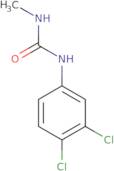N-Demethoxy linuron
CAS : 3567-62-2
Ref. 3D-FD20983
| 1g | Arrêté | ||
| 50mg | Arrêté | ||
| 100mg | Arrêté | ||
| 250mg | Arrêté | ||
| 500mg | Arrêté |
Informations sur le produit
- N-(3,4-Dichlorophenyl)-N'-methylurea1-(3,4-Dichlorophenyl)-3-methylurea1-Methyl-3-(3,4-dichlorophenyl)urea
- 1-Methyl-3-(3,4-dichlorophenyl)urea
- 3,4-Dcpmu
- 3-(3,4-Dichlorophenyl)-1-methylurea
- Dcpmu
- Diuron metabolite
- Linuron metabolite
- Methazole metabolite
- Monomethyldiuron
- N-(3,4-Dichlorophenyl)-N′-methylurea
- Voir d'autres synonymes
- N-Demethoxylinuron
- N-Methyl-N′-(3,4-dichlorophenyl)urea
- Urea, 1-(3,4-dichlorophenyl)-3-methyl-
- urea, N-(3,4-dichlorophenyl)-N'-methyl-
N-Demethoxy linuron is a carbonyl compound that has been used as a fungicide and bactericide. It has been shown to have high activity against the gram-positive bacteria Staphylococcus aureus and Bacillus subtilis, but not the gram-negative bacteria Escherichia coli, Pseudomonas aeruginosa, Klebsiella pneumoniae, or Proteus vulgaris. The carbonyl group of N-demethoxy linuron reacts with nucleophilic sites on bacterial enzymes such as cytochrome P450s and glutathione reductase. This reaction leads to the formation of cleavage products that are more toxic than the parent molecule. The half-life values for N-demethoxy linuron in soil vary from 1 to 3 days. This may be due to its adsorption mechanism onto soil particles.





